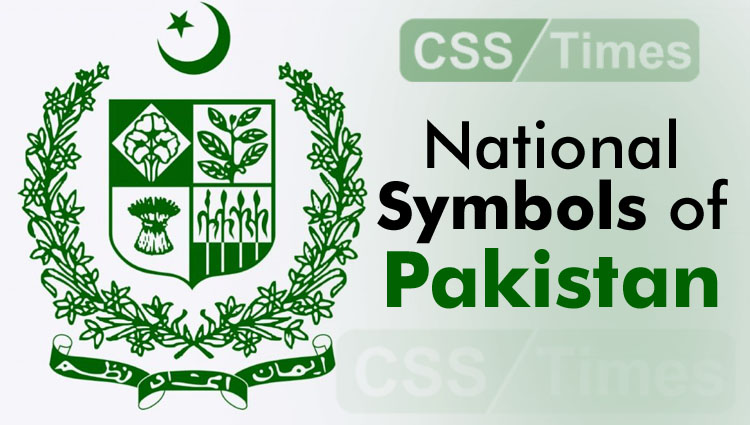National Symbols of Pakistan | Pakistan General Knowledge
Nation’s Motto of Pakistan
The scroll supporting the shield contains Muhammad Ali Jinnah’s motto in Urdu, which reads as “Iman, Ittehad, Nazm” translated as “Faith, Unity, Discipline” and are intended as the guiding principles for Pakistan.
Official Map of Pakistan
Official Map of Pakistan is that which was prepared by Mahmood Alam Suhrawardy
National Symbol of Pakistan
Star and crescent is a National symbol. The star and crescent symbol was the emblem of the Ottoman Empire in the 19th century, and gradually became associated with Islam in late 19th-century Orientalism.
National Epic of Pakistan
The Hamza Nama or Dastan-e-Amir Hamza narrates the legendary exploits of Amir Hamza, an uncle of the Prophet Muhammad, though most of the stories are extremely fanciful, “a continuous series of romantic interludes, threatening events, narrow escapes, and violent acts
National Calendar of Pakistan
Fasli which means (harvest) is derived from the Arabic term for division, which in India was applied to the groupings of the seasons. Fasli Calendar is a chronological system introduced by the Mughal emperor Akbar basically for land revenue and records purposes in northern India. Fasli year means period of 12 months from July to June.
National Reptile of Pakistan
The mugger crocodile also called the Indian, Indus, Persian, Sindhu, marsh crocodile or simply mugger, is found throughout the Indian subcontinent and the surrounding countries, like Pakistan where the Indus crocodile is the national reptile of Pakistan
National Mammal of Pakistan
The Indus river dolphin is a subspecies of freshwater river dolphin found in the Indus river (and its Beas and Sutlej tributaries) of India and Pakistan. This dolphin was the first discovered side-swimming cetacean. It is patchily distributed in five small, sub-populations that are separated by irrigation barrages
National Fish of Pakistan
Tor putitora, the Putitor mahseer, Himalayan mahseer, or golden mahseer, is an endangered species of cyprinid fish that is found in rapid streams, riverine pools, and lakes in the Himalayan region and south Asia
National Amphibian of Pakistan
Bufo stomaticus (commonly known as the Indian marbled toad, Indus Valley toad, or marbled toad) is a species of toad found in Asia from Iran, Pakistan, Afghanistan to Nepal extending into Peninsular India from the plains to about 1800m. It is particularly common in the Indus valley.
National Predators of Pakistan
The snow leopard is a large cat native to the mountain ranges of Central and South Asia. It is listed as endangered species. As of 2016, estimates for the size of the global population vary from at least 4,080 to about 8,700 individuals.
National Dance of Pakistan
Kathak is one of the ten major forms of Indian classical dance. The origin of Kathak is traditionally attributed to the traveling bards of ancient northern India, known as Kathakars or storytellers.
National Instrument of Pakistan
The daf is a large Persian frame drum used in popular and classical music. The frame is usually made of hardwood with many metal ringlets attached, and the membrane is usually goatskin. Daf is mostly used in Arabia, Egypt, the Levant, Iraq, Azerbaijan, Iran, Armenia, Turkey, Pakistan and Afghanistan.
Check Also: World General Knowledge MCQs
National Dish of Pakistan
Biryani is a National dish of Pakistan. Biryani also known as biriyani or biriani, is a South Asian mixed rice dish with its origins among the Muslims of the Indian subcontinent.
National Icon of Pakistan
The Teen Talwar (Three Swords) monument is located in Clifton, Karachi, Sindh, Pakistan. The three marble swords are inscribed with Quaid-e-Azam Mohammad Ali Jinnah’s creeds Unity, Faith and Discipline. It was commissioned by Pakistan’s former President and Prime Minister, Zulfikar Ali Bhutto.
National Mountain of Pakistan
K2, also known as Mount Godwin-Austen or Chhogori is the second highest mountain in the world, after Mount Everest, at 8,611 metres (28,251 ft) above sea level. It is located on the China-Pakistan border between Baltistan, in the Gilgit–Baltistan region of northern Pakistan and the highest point in Pakistan. K2 is known as the Savage Mountain due to the extreme difficulty of ascent.
National River of Pakistan
The Indus River is a major south-flowing river in South Asia. The total length of the river is 2896 which makes it one of the longest rivers in Asia. It is originated from the western part of Tibet. It is the longest river and National river of Pakistan.
National Flag of Pakistan
Pakistan’s National Flag comprises dark green colour with Crescent and Star in it and a vertical white stripe. Green part shows the majority of Muslims and white stripe represents minorities of Pakistan. Syed Amir ud Din Kidwai designed this flag based on the flag of All India Muslim League. It was approved by Constituent Assembly on 11 August, 1947.
National Emblem/ Logo of Pakistan
National Emblem was adopted in 1954. Its colour is green. Crescent and Star is at the top while Urdu version of Quaid’s Motto Faith, Unity and Discipline (ایمان’ اتحاد’ تنظیم) are written at bottom. In the centre, four major crops of that time (cotton, wheat, tea and jute) are shown in a form of shield and signify the importance of agriculture. This shield is surrounded with beautiful floral design.
National Anthem of Pakistan
- “Pak Sarzamee Shad Baad” is the national anthem of Pakistan. At the time of Independence, Pakistan has not any national anthem. Ahmed Ghulam Ali Chagla created the composition without lyrics. Later on., Abu Al Asar Hafeez Jullandhri wrote its lyrics. National Anthem of Pakistan is unique as its music preceded its lyrics. National Anthem was first time broadcast on Radio Pakistan on 13 August, 1954 while formally announced by government on 16 August 1954 followed by a performance of 11 singers including Ahmed Rushdi.
Check Also: Global Giants: Exploring Prominent International Organizations
National Language of Pakistan
Urdu is national language of Pakistan while English is official language of Pakistan. Punjabi, Sindhi, Pashto, Balochi, Seraiki and many other regional languages are also spoken.
Great Leader / Father of the Pakistani Nation
Quaid-e-Azam Muhammad Ali Jinnah is the founder of Pakistan. He is regarded as father of the nation. Baba e Qaum and Quaid-e-Azam are his titles. He was a lawyer by profession. Muhammad Ali Jinnah served the All India Muslim League from 1913 till 14 August 1947. He was the first Governor General of Pakistan. He died 11 September 1948 at the age of 71 years.
Mother of the Pakistani Nation
Fatima Jinnah is regarded as the mother of Pakistani nation and known as Madr-i-Millat. She was the younger sister of Quaid-e-Azam. She was a dental surgeon by profession. She actively participated in independence movement with his brother. After independence, she participated in politics of Pakistan. She died on 9 July 1967 at the age of 73 years.
National Poet of Pakistan
Allama Muhammad Iqbal is the national poet of Pakistan. He was a great poet, philosophy, scholar and leader of Pakistan Movement. He was poet of Urdu and Persian languages. He was born in Sialkot. He gave the idea of Pakistan and Pakistanis also known him as Musawar-e-Pakistan.
National Masjid of Pakistan
Faisal Masjid Islamabad is the national masjid of Pakistan. It is the largest masjid in Pakistan. It was designed by a Turkish Architect Vedat Dalokay in the form of a desert tent. It is named after the late king of Saudi Arabia, Shah Faisal bin Abdul Aziz. Faisal Masjid was completed in 1986. It has 4 minarets of 90m height, 5000 sq. meters is covered area. It has capacity of 74,000 persons in main areas while another 200,000 persons in adjoining grounds.
National Monuments of Pakistan
Pakistan Monument Islamabad and Bab-e-Pakistan Lahore are two national monuments of Pakistan. National Monument Islamabad was completed in 2007. It represents four provinces and three territories of Pakistan. It is located on Shakar Parian Hills of Islamabad. Bab-e-Pakistan (Gateway to Pakistan) is built on the site of a major refugee camp at the time of dependence.
National Library of Pakistan
National Library of Pakistan is located at Constitution Avenue, Islamabad. It was inaugurated in 1993. It also serves as cultural centre of Islamabad and a working place for Scholars and students.
National Mausoleum of Pakistan
Mazar-e-Quaid is regarded as national mausoleum of Pakistan. Tomb of Quaid-e-Azam Muhammad Ali Jinnah is at this place in Karachi.
National Dress of Pakistan
Shalwar Kameez is the national dress of Pakistan. It has some variation for men and women.
National Sports of Pakistan
Field Hockey (or simply Hockey) is the national sport of Pakistan. However Cricket is most popular sport in Pakistan. Squash, Badminton, Boxing, Volley Ball and Kabadi are also played in Pakistan.
National Animal of Pakistan
Markhor is the national animal of Pakistan. It usually found on mountains. Its height is about 26 to 45 inches and weight is about 40 to 100 kg. Its colour is tan while sometimes it has white and black shades too. These have corkscrew shaped horns; up to 65 inches long in males and up to 10 inches in females.
National Bird of Pakistan
Chukar is the national bird of Pakistan. It is a beautiful bird with light brown back, grey chest and buff belly. Its face is white with black border. Its sound is very nice to listen.
National Flower of Pakistan
Jasmine or Gardenia is the national flower of Pakistan. It belongs to the coffee family of plants and has about 250 species of flower plants.
National Tree of Pakistan
Deodar or Cedrus Deodara is the national tree of Pakistan. Its height is about 40 to 60m long and its trunk may be of up to 3m diameter.
National Drink of Pakistan
Sugarcane Juice is national drink (beverage) of Pakistan. It is called “Roh” in Pakistan. In summer season, you can easily find a vendor selling fresh sugarcane juice in Pakistan.
National Fruit of Pakistan (Summer)
Mango is the national fruit of summer of Pakistan. Mango is indigenous to sub-continent. There are different kinds and varieties of mangoes.
National Fruit of Pakistan (Winter)
Guava is the national fruit of winter of Pakistan.
National Religion
National Religion of Pakistan is Islam. Islam is religion which professes that there is only one and incomparable God (Allah) and that Muhammad (PBUH) is the last messenger of God. It is the world’s second-largest religion and the fastest-growing major religion in the world, with over 1.7 billion followers or 23% of the global population, known as Muslims.
National Tower | National Symbols of Pakistan
National Tower of Pakistan is Minar-e-Pakistan. Minar-e-Pakistan (“Tower of Pakistan”) is a public monument located in Iqbal Park which is one of the largest urban parks in Lahore, Punjab, Pakistan. The tower was constructed during the 1960s on the site where, on 23 March 1940, the All-India Muslim League at the time of British colonial rule over British India passed the Lahore Resolution.
State Bird of Pakistan
State Bird of Pakistan is Peregrine Falcon. The peregrine falcon also known as the peregrine, and historically as the duck hawk in North America, is a widespread bird of prey in the family Falconidae. A large, crow-sized falcon, it has a blue-grey back, barred white underparts, and a black head. The peregrine is renowned for its speed, reaching over 320 km/h (200 mph) during its characteristic hunting stoop (high speed dive), making it the fastest member of the animal kingdom.
National Vegetable | National Symbols of Pakistan
National Vegetable of Pakistan is Lady Finger. Okra or okro known in many English-speaking countries as ladies’ fingers, ochro or gumbo, is a flowering plant in the mallow family. It is valued for its edible green seed pods. The geographical origin of okra is disputed, with supporters of West African, Ethiopian, and South Asian origins. The plant is cultivated in tropical, subtropical and warm temperate regions around the world National Symbols of Pakistan.
National Colours
National Colours of Pakistan are Green & White. White is an achromatic color, a color without hue. Green is the color between blue and yellow on the spectrum of visible light. It is evoked by light with a predominant wavelength of roughly 495–570 nm.
National Airline | National Symbols of Pakistan
National Airline of Pakistan is PIA. Pakistan International Airlines commonly known as PIA is the national flag carrier of Pakistan. Its main hub is Karachi while Lahore and Islamabad are its secondary hubs. The airline was nationalized on 10 January 1955 and was renamed Pakistan International Airlines. Its first international flight was in 1955, operating to London, via Cairo and Rome. National Symbols of Pakistan
National Day
National Day of Pakistan is 23rd March. Pakistan Day is a public holiday in Pakistan to remember the Lahore Resolution on March 23 each year. The word “Pakistan” was never used but the Lahore Resolution is considered a major milestone in the Muslim struggle for an independent state in undivided India National Symbols of Pakistan.
National Document | National Symbols of Pakistan
National Document of Pakistan is Lahore Resolution. The Lahore Resolution commonly known as the Pakistan Resolution was a political resolution, or statement drafted between 22nd to 24th March 1940, by the 25-member Working Committee of the All-India This resolution asked for greater Muslim autonomy within British India. However, later on most people thought of this as a call for a separate Muslim state, Pakistan. The resolution was presented at Minto Park in Lahore, by Maulvi A.K. Fazlul Huq on 23 March 1940.
Before you leave check Other important articles/MCQs about World General Knowledge
- 10 Shocking Facts About Pakistan That Will Amaze You
- اہم عالمی معلومات (MCQs)
- Global Giants: Exploring Prominent International Organizations
- 10 Surprising Facts About the Human Brain You Didn’t Know
- World Labour Day Tribute: Honouring Workers
- World Health Day | Building a Fairer, Healthier World
- The World Wars: A Global Struggle for Power and Ideology
- Important World General Knowledge One Liners
- An Overview of the Punjab Assembly: How it Works and what it does
- 10 Attractive Facts About Pakistan You Must Know








I think u should correct this information.
Major Crops are
Wheat
Rice
sugarcane
Cotton
In the centre, four major crops of that time (cotton, wheat, tea and jute) are shown in a form of shield and signify the importance of agriculture.
[…] Check Also: National Symbols of Pakistan […]